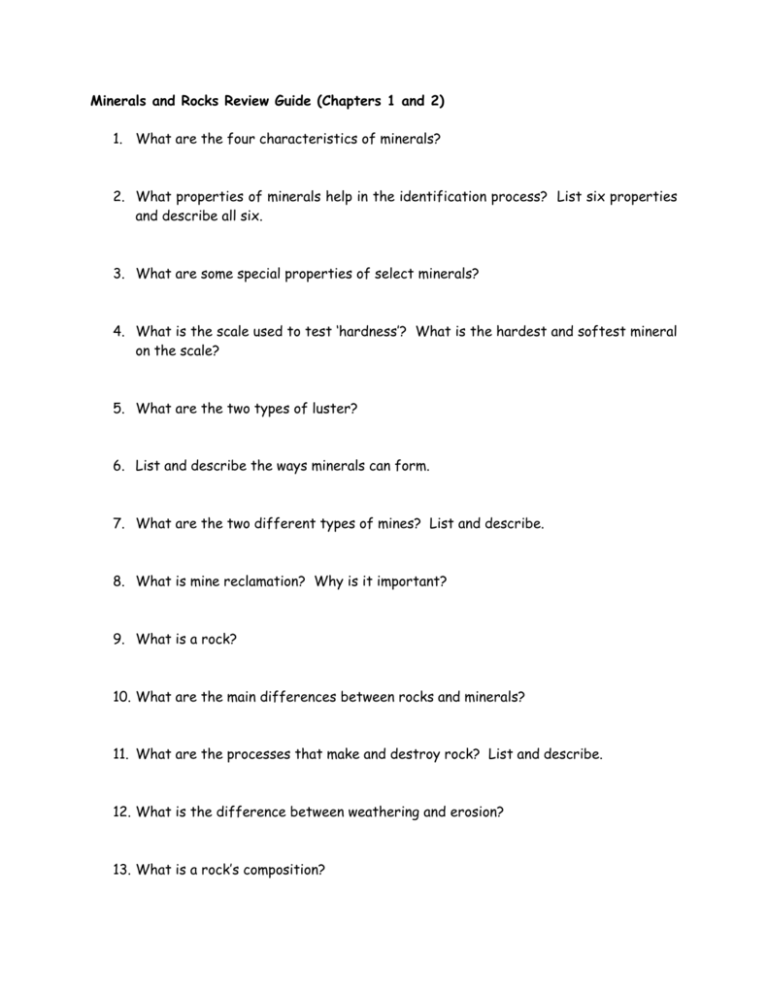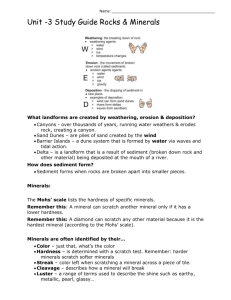Minerals and Rocks Review Guide (Chapters 1 and 2) What are the
advertisement

Minerals and Rocks Review Guide (Chapters 1 and 2) 1. What are the four characteristics of minerals? 2. What properties of minerals help in the identification process? List six properties and describe all six. 3. What are some special properties of select minerals? 4. What is the scale used to test ‘hardness’? What is the hardest and softest mineral on the scale? 5. What are the two types of luster? 6. List and describe the ways minerals can form. 7. What are the two different types of mines? List and describe. 8. What is mine reclamation? Why is it important? 9. What is a rock? 10. What are the main differences between rocks and minerals? 11. What are the processes that make and destroy rock? List and describe. 12. What is the difference between weathering and erosion? 13. What is a rock’s composition? 14. What is a rock’s texture? 15. How do igneous rocks form? 16. What is the difference between intrusive and extrusive igneous rocks? 17. What will a rock look like if it cools quickly? What will it look like if it cools slowly? 18. How does sedimentary rock form? 19. What are the three types of sedimentary rock? List and describe. 20. What is stratification? 21. How does metamorphic rock form? 22. What is the difference between contact and regional metamorphism? 23. What is the difference between foliated and nonfoliated metamorphic rock? 24. What is deformation? 25. Be able to label and explain the rock cycle. Minerals and Rocks Review Guide (Chapters 1 and 2) 1. What are the four characteristics of minerals? Minerals are 1)naturally formed, 2) Solid, 3) Inorganic, and 4) Have a crystal structure 2. What properties of minerals help in the identification process? List six properties and describe all six. 1. Color – Outward appearance of the mineral 2. Streak – The color of the powder that a mineral leaves on a piece of porcelain 3. Luster – The way the surface of the mineral reflects light 4. Cleavage or Fracture – The ability of a mineral to break along smooth, flat surfaces (cleavage) or the tendency to break along irregular surfaces (fracture) 5. Hardness – A minerals resistance to being scratched 6. Density – The amount of mass per given volume (m/v) 3. What are some special properties of select minerals? Fluorescence, chemical reactions (fizzing), optical properties (double image), magnetism, taste, and radioactivity 4. What is the scale used to test ‘hardness’? What is the hardest and softest mineral on the scale? Moh’s hardness scale can be used to test the hardness of a mineral. Diamond is the hardest mineral on the scale with a hardness of 10 and talc is the softest mineral on the scale with a hardness of one. 5. What are the two types of luster? A mineral can have metallic or nonmetallic luster. 6. List and describe the ways minerals can form. - Evaporation – When a body of salt water dries up minerals such as halite and gypsum can be left behind - Metamorphic Rocks – changes in temperature and pressure can alter the chemical makeup and form new minerals - Limestone – Dissolved minerals can be deposited in bodies of water and crystallize on the bottom - Hot-water Solutions – Groundwater can be heated by magma and react to form hot solutions. Dissolved metals and elements can crystallize from the solution to form minerals - Pegmatites - A tear-drop shaped intrusion underground where minerals form and crystallize - Plutons – When magma moves upwards it will stop moving before it reaches the surface and cool slowly forming minerals 7. What are the two different types of mines? List, describe, and give an example. 1) Surface Mining- Minerals are at or near the surface and are mined from the top of the Earth and layered down. An example is a quarry. 2) Subsurface Mining – Used when mineral deposits are located too deep with the Earth to be surface mined. An example would be any mine with shafts. 8. What is mine reclamation? Why is it important? Mine reclamation is the process in which land that was mined is returned to its original condition after mining is completed. Reclamation is important because it can reduce the potential harmful effects of mining. 9. What is a rock? Rocks are naturally occurring solids that are made of a mixture of one or more minerals and organic material. 10. What are the main differences between rocks and minerals? Rocks – Mixture of minerals and organic (once living) material Minerals – Definite composition and inorganic material 11. What are the processes that make and destroy rock? List and describe. Weathering – The breakdown or rock into sediment due to wind, water, etc. Erosion – The movement of sediment from one place to another Deposition – The settlement of sediment in a specific location typically in bodies of water or low-lying areas Heat/Pressure – Extreme heat and pressure causes rock to go through metamorphism Uplift – The movement within the Earth that causes rock inside the Earth to move to the surface 12. What is the difference between weathering and erosion? Weathering breaks the rock into fragments called sediment and erosion is simply the movement of that sediment to another location. 13. What is a rock’s composition? The chemical makeup of the rock; either mineral types or other materials. 14. What is a rock’s texture? The texture is based upon the size of the rock’s grains. Rocks can either be fine-grained, medium-grained, or coarse-grained. 15. How do igneous rocks form? Igneous is the type of rock that forms when magma or lava cools and solidifies. 16. What is the difference between intrusive and extrusive igneous rocks? Intrusive – Rock formed from the cooling and solidification of magma within the Earth’s surface; typically coarse-grained and cool very slowly. Extrusive – Rock that forms due to volcanic activity at or near the Earth’s surface; typically very small crystals or no crystals at all and cools very quickly 17. What will a rock look like if it cools quickly? If a rock cools quickly it will have small crystals or look glassy. What will it look like if it cools slowly? If a rock cool slowly there will be larger crystals and it will be coarse-grained. 18. How does sedimentary rock form? Sedimentary rock forms at or near the Earth’s surface without heat and pressure. Instead, sedimentary rock is formed when compaction and cementation occur. 19. What are the three types of sedimentary rock? List and describe. Clastic – Made from fragments of rock cemented together by a mineral Chemical – Made from solutions of dissolved minerals and water that go through crystallization Organic – Made from the remains of once-living plants and animals 20. What is stratification? Stratification is the process in which sedimentary rocks are arranged in layers or strata 21. How does metamorphic rock form? Metamorphic rock forms through metamorphism in which the rock changes form due to heat and pressure 22. What is the difference between contact and regional metamorphism? Contact metamorphism – Occurs near igneous inclusions by the intense heat of the magma Regional metamorphism – Pressure builds up in rock that is buried deep below other rock formation. This pressure causes rock to become deformed and chemically change 23. What is the difference between foliated and nonfoliated metamorphic rock? Foliated metamorphic rock will contain aligned grains of flat minerals and nonfoliated rock does not have aligned minerals 24. What is deformation? Deformation is the change in shape of a rock caused by a force placed on the rock causing it to squeeze or stretch 25. Be able to label and explain the rock cycle.







